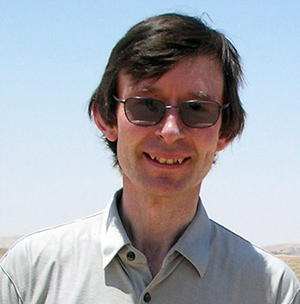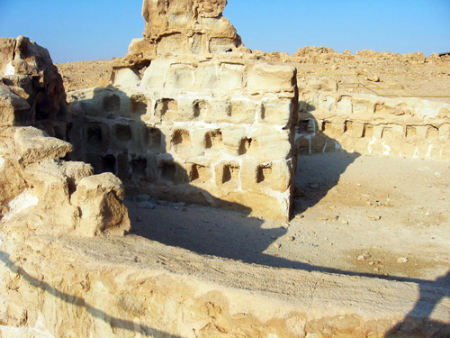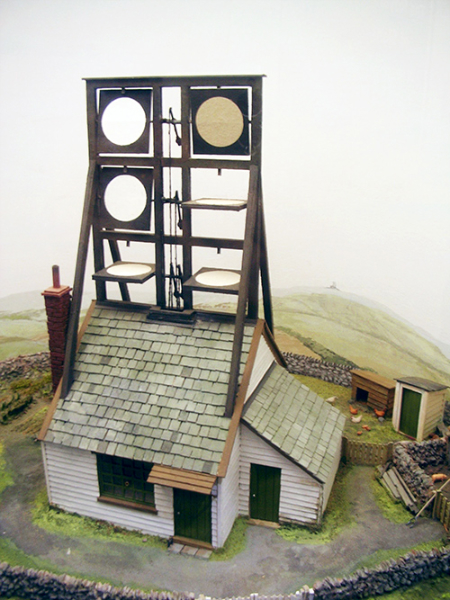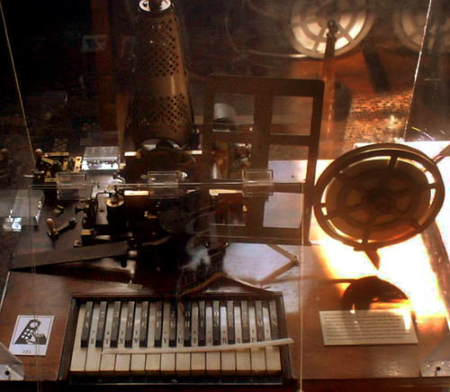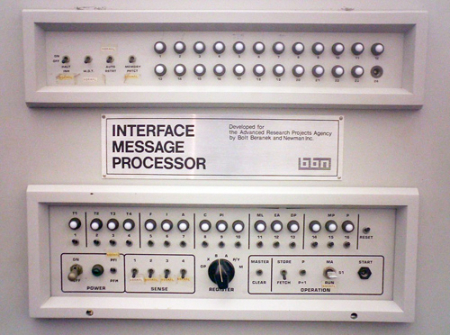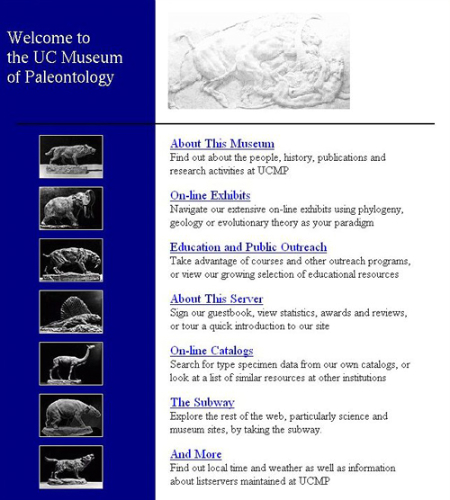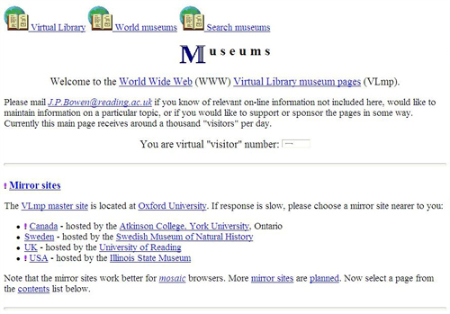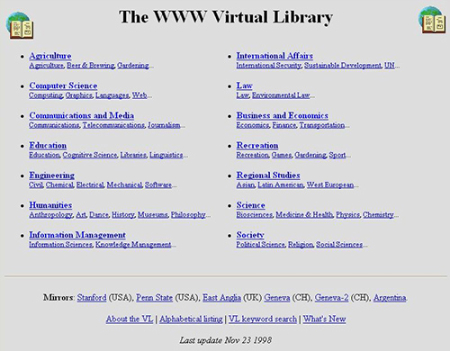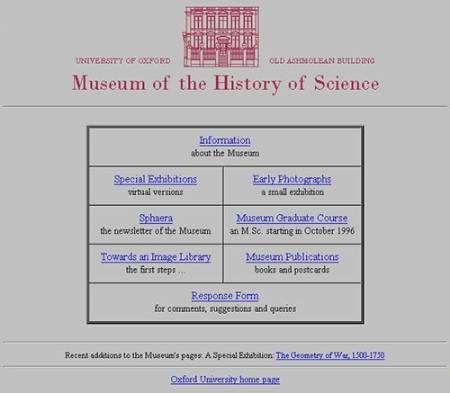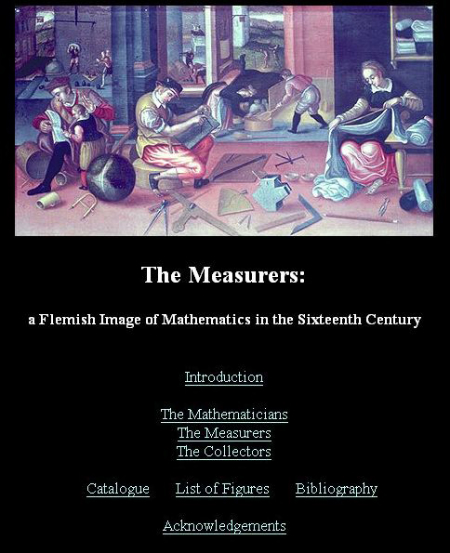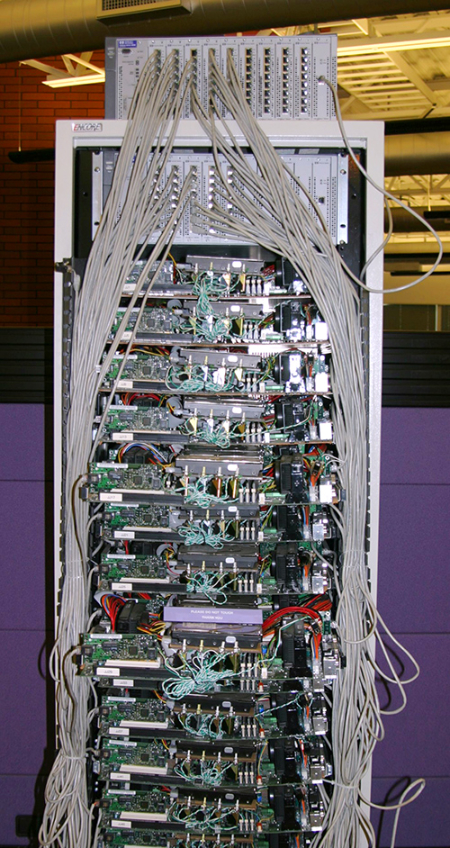A Brief History of Early Museums Online
Background
Museums are in a unique position of both recording the history of human communication through networks and also using the medium to their own advantage. Fast communication of messages at long distance dates back much earlier than the Internet on which many people rely today. For example, at Masada in Israel, there are the remains of a two thousand year old columbarium tower or dovecot (see Figure 1) on the well-fortified hilltop, now a UNESCO World Heritage Site, which could have enabled communication with the outside world from this isolated outpost. During the Napoleonic Wars of the late 18th and early 19th century, in England a set of shutter telegraph links was set up from London to allow fast communication with the navy on the coast, as presented at the Royal Signals Museum (see Figure 2). Of course there was a delay as each relay station forwarded the message since line-of-sight viewing was necessary between each neighbouring location. Later in the 19th century, optical communication techniques gave way to electrical communication in the form of the electrical telegraph, using cable connections and eventually via wireless signals (see Figure 3). This has been dubbed the ‘Victorian Internet’ in the light of later developments (Standage, 1998).
In the late 20th century, telecommunications of all sorts became increasingly dominated by computer networks and specifically the Internet, which started as the ARPANET, originally in 1969 with four nodes in the US. The original connection at each node was via a computer-based Interface Message Processor (IMP), designed in the 1960s by Bolt, Beranek and Newman, Inc. (BBN), which provided the first packet router for the ARPANET. Communication was via packet switching protocols that became standardized as the underlying TCP/IP protocols (Transmission Control Protocol/Internet Protocol), forming the universal transport layer for various application protocols. The latter include SMTP (Simple Mail Transfer Protocol) for electronic mail and FTP (File Transfer Protocol) for general data transfer.
In the late 1980s, Tim Berners-Lee at CERN, the international physics facility in Switzerland, devised the first version of the relatively simple HTTP (Hypertext Transfer Protocol) as a basis for communication of hyperlinked documents in HTML (Hypertext Markup Language) and other files from remote servers for display on clients’ web browsers, as part of his newly proposed World Wide Web (Berners-Lee, 1999). This gave raise to a rapid expanse in the public use of the Internet in many different fields, including museums.
The WWW Virtual Library
As the web expanded rapidly in the early 1990s, Tim Berners-Lee realised that some form of directory was needed to aid finding the various websites that were available (Gillies & Cailliau, 2000). However, the effort required for this was increasing exponentially since the web was doubling in size every few months. Arthur Secret visited CERN, joined Berners-Lee on his web project, and took over the running of the ‘Virtual Library’ of links to websites around the world (now under vlib.org). Secret became the first true ‘virtual librarian’ on the web. He realised that the maintenance of the Virtual Library could not be sustained by a single person. He was contacted by the University of Kansas and a history professor there was the first to take over a Virtual Library section in a particular area.
In the meantime, as an Internet user since the mid 1980s, and based at the Programming Research Group (PRG) within the Oxford University Computing Laboratory (OUCL) as a Research Officer, I discovered the World Wide Web through use of the Mosaic browser in the early 1990s. The first time I used it, the speed was extremely slow and as a result very unimpressive. This was when the Internet link between Europe and the US available for academics was still less than a 10mbps Ethernet connection normally available in a local area network, so the speed problems were not surprising. There was also little content available and it was difficult to find without knowing a particular Uniform Resource Locator (URL) or finding a hyperlink within a web page. Mosaic only ran under X windows on the Sun workstations prevalent in the PRG at the time and I was still using Sun’s own operating system SunOS on a day-to-day basis. At the time it did not provide enough incentive to change operating systems on a permanent basis.
However, I tried again a few months later and the situation was somewhat better. I discovered the Virtual Library, which allowed navigation to a range of websites without prior knowledge of their URL. At the time, the range of subject areas was relatively limited. The main academic fields, especially in science, were covered, but not much else.
With a wife who was a museum curator, I was one of a small number of people online with access to the World Wide Web and an interest in museums. As I learnt to navigate the web, I gradually found a number of early online museum-related resources, especially in the United States. Notable examples included the University of California Museum of Palaeontology at Berkeley in the US (see Figure 5 and web.archive.org/web/19970606010526/www.ucmp.berkeley.edu for a 1997 version of the home page) and the EXPO online exhibition from the US Library of Congress (still archived and in existence today under www.ibiblio.org/expo).
There were also less official resources (that became dubbed as ‘virtual museums’), such as the WebLouvre, initiated by a French student, Nicolas Pioch, which presented high-quality (for the time) copies of works of art by leading historical artists. This was renamed to the WebMuseum for legal reasons, once the actual Louvre discovered the web and this (completely altruistic, educational and not-for-profit) resource. Although the Louvre would probably have liked to eliminate it completely, this was impossible in practice since its popularity meant that it was mirrored on many websites around the world to improve download speeds on the then relatively slow Internet connections available, especially internationally. It is still available online as a historical record (see www.ibiblio.org/wm) and many of the mirror sites remain too.
Being based in a computer science department, and as a previous provider of online resources through FTP and via email for topics concerning my computing research interests, I had relatively easy access to file space on the OUCL’s web server when it became installed. Like many computer science departments, OUCL have an existing FTP service and briefly ran a Gopher server (similar to but rather more limited then a web server) before the facilities of a web server effectively made this redundant through its superior features. The naming facility of the web using URLs cleverly allowed existing resources available through protocols other than the web’s native HTTP protocol (e.g., particularly FTP and Gopher) to be accessed easily.
Virtual Library Museum Pages
Among the pages that I installed on the OUVL web server was a page with a list of links to museum-related websites that I discovered as I traversed the web, essentially created as a personal bookmarking resource, but also available to anyone else surfing the web. This was part of an ‘archive service’ that I created at OUCL for computing-related resources. Files such as documents had previously been available via FTP and an email service that automatically responded to requests sent as commands by electronic mail, thus allowing those with email-only contact on the Internet to access resources. This was much enhanced by the availability of the OUCL web server and the service is still accessible today as the OUCL Archive Service (see archive.comlab.ox.ac.uk), although some of the resources have since been moved to other web servers.
Realising that museum resources available online could be of great and growing interest to web users, but that finding them could be difficult, I decided I would offer to incorporate my museums web page into the Virtual Library. This was a relatively informal process. On 16 June 1994, I emailed the Virtual Library maintainer, Arthur Secret at CERN, offering my web page for inclusion (see Figure 6). I included the Virtual Library logo (the world with an open book in front of it) at the top of my museums page with a link to the main Virtual Library page (see Figure 7). In return, Arthur Secret added a link to the museums page from the Virtual Library page (see Figure 8).
Very soon the page was receiving a significant number of hits. This was easy to check using the web server statistics log that recorded information on every access to the server (including the host name or IP address, date, time and resource accessed). Some simple statistics software allowed this information to be presented in a meaningful manner, with details of accesses by day, time of day, etc. It proved to be the most popular web page on the OUCL web server. For example, in the statistics for 27 April to 4 May 1996 (still available under archive.comlab.ox.ac.uk/other/ museums/stats-apr96.html), the page received 11,864 hits during this week’s period. Before long, it was also the most popular page on the Virtual Library, which collected and displayed its own statistics.
The resource became known as the Virtual Library museums pages (VLmp) (Bowen, 1995d; Bowen, 1997a; Bowen, 1997b; Bowen, 2002). Initially usage doubled every three months, with up to 3,000 virtual ‘visitors’ per day, similar to the actual number of visitors to a large museum. In 1996, through the interest of Cary Karp in Sweden, VLmp was adopted by the International Council of Museums (ICOM), the leading international museums organization (Bowen, 1996a). This resulted in the main mirror site and URL being moved to the ICOM web server, where it is still available today (vlmp.icom.museum). The site was (and still is) copied on a daily basis via FTP. A number of other mirror sites were established around the world early in the life of VLmp, when access speed internationally was much more of an issue than it is today.
Like the Virtual Library itself, before long the maintenance of VLmp became too much for one person and devolved. The first section to be maintained separately was that for Canada by the Canadian Heritage Information Network (CHIN), which already provided support concerning Information technology to museums in Canada. Offers for the maintenance of museums in other countries were made, including the Museums Documentation Association (MDA) in the UK, and the community of VLmp maintainers grew to around twenty. Such is the power of virtual communities, I did not physically meet most of the people involved, and indeed I have still not met many of them since they are geographically distributed around the world.
The first public announcement of VLmp in print media was in the Times Higher Education Supplement on 10 March 1995 (Bowen, 1995a). Not long afterwards, on 10 May 1995, a one-day meeting on ‘Museum Collections and the Information Superhighway’ was organized by John Griffiths and others at the Science Museum in London, England. This proved to be an important gathering of people interested in the development of online museums. For example, David Bearman, based in the US, attended and went on to found the Museums and the Web conference in 1997, which has been running annually in North America ever since. While most presenters concentrated on the future, in the case of the Virtual Library museums pages it was possible to present existing use of the web to access online museum resources, with real visitor statistics to demonstrate the phenomenon was already underway even for the museum sector (Bowen, 1995c).
The proceedings of this early meeting were made available online by the Science Museum as well as in print form. Unfortunately museums often do not appreciate the archival use of the web for historic information and the proceedings have been removed from the Science Museum website. Fortunately, the excellent Archive.org website does keep a permanent record of much of the important early material available on the web from 1996 onwards and the proceedings are still accessible through this excellent resource of historical record (see web.archive.org/web/19990120003322/ www.nmsi.ac.uk/infosh/infosh.htm).
The Museums Journal is the leading professional museums journal in the United Kingdom. On realising the potential importance of the rapidly growing web to museums in communication with their potential and actual visitors, I sent printouts of example museum-related web pages to the editor as early as 1994. There was no response at this point, presumably because of the lack of awareness of the web at this stage amongst those with no connection to the Internet. However, it is likely that the meeting at the Science Museum had a significant impact on raising awareness in the UK museum community. In any case, the Museums Journal contacted me in 1995, resulting in an article about online museums and VLmp appearing in the journal’s August 1995 issue (Bowen, 1995c).
As well as real museums creating associated websites online, an associated phenomenon has been the creation of ‘virtual museum’ websites with no related actual museum. As an example, in association with the Virtual Library museums pages, I started the Virtual Museum of Computing (VMoC) on the OUCL web server on 1st June 1995. It presented some virtual exhibits and links to resources concerning the history of computing. Within a week it was attracting around a hundred online visitors each day. Andrew Hodges, based in Oxford and the biographer of Alan Turing, the computing pioneer, included his website within the VMoC framework as a ‘virtual curator’ (Bowen et al., 2005). The VMoC site was first formally announced in the print media in the IEEE Annals of the History of Computing journal in 1996 (Bowen, 1996b). It has been continuously available and augmented since its inception within the Virtual Library and VLmp framework (for the current website, see museums.wikia.com/wiki/VMoC).
Early museums online—two examples
During the 1990s, as the web expanded, the computer science community made some effort to help museums in developing online access to material through collaborative projects (Mannoni, 1996). Online museums were not a mainstream interest for those in the thick of developments at the time, although Negroponte (1995) considered the Internet to be a good potential forum for future artistic endeavours. The informed museum community was aware of the developments and implications, discussing the long-term impact of Information Technology on the way museums function (Jones-Garmil, 1996). However, the main museums with early websites tended to be those with academic associations since this gave them relatively easy and cheap access to the Internet and to the expertise needed to install and run a web server. The example of the University of California’s Museum of Palaeontology has already been mentioned. Here we give two further examples of museums that were early adopters of the web.
The London Science Museum’s origins date from 1857 when collections formed from the Royal Society of Arts and the 1851 Great Exhibition were used to create part of the South Kensington Museum. In 1883 the scientific collections were named separately as the Science Museum and an independent director was appointed in 1893. The Science Museum’s computing collections now include part of Charles Babbage’s Difference Engine and the Pilot ACE, a preliminary version of the planned Automatic Computing Engine (ACE), which was originally designed by Alan Turing at the National Physical Laboratory in 1946.
The Natural History Museum nearby was the first museum in the United Kingdom to have its own web server in 1994 (under www.nhm.ac.uk) and the National Museum of Science and Industry (including the Science Museum as well as other related museums) followed soon after (under www.nmsi.ac.uk). With Imperial College next door to both museums, and an academic remit in their own right, they were able to connect to the JANET academic network relatively easily, hence the ‘.ac.uk’ top-level domain.
The Science Museum has been at the forefront of web developments among museums. As well as ‘The Information Superhighway’ meeting in 1995 as mentioned earlier and an exhibition on the subject at that time too, it introduced ‘exhibitlets’ on its website in 1998 (to present more dynamic exhibition material using Java applet technology). The InTouch exhibition in the Wellcome wing took a step further in allowing visitors to record their interactions in the gallery for later private viewing via the web (www.sciencemuseumintouch.org.uk). Their presence was detected by their finger print in each exhibit and some 170,000 personal websites were created (Bowen et al., 2005).
The Museum of the History of Science, part of the University of Oxford, also had the advantage of easy, relatively fast and effectively free Internet connectivity through its university association. The museum itself is housed in the historic Old Ashmolean Building, originally built in 1683 to house the Ashmolean Museum. The Museum of the History of Science itself was founded in 1924. The collection is mainly used for teaching and includes 15,000 objects, such as mathematical instruments (used for astronomy, calculating, drawing, navigation, surveying) and scientific instruments. A Master of Science course is taught by museum personnel and it holds special temporary exhibitions.
The museum’s first website was initiated in 1995 (under www.mhs.ox.ac.uk, see also Figure 9). That year, the museum staged the exhibition The Measurers: a Flemish Image of Mathematics in the Sixteenth Century, simultaneously in the gallery, on a gallery computer, and via the Internet. This is still available on the museum’s website today, an excellent example of reliable digital preservation by a museum (see www.mhs.ox.ac.uk/measurer/text/contents.htm and Figure 10). Since the start, the museum has prided itself on placing very high-resolution images of objects and other material in the collection online, rivalling the view available in the museum itself. Initially, these digital images were very slow to download for those on sluggish Internet connections (e.g., via telephone lines), but with the advent of widespread broadband access, this is now much less of an issue. It is now possible for the general public to appreciate these archived online exhibitions at a reasonable speed.
As well as online exhibitions, the museum has been keen to provide online databases relating to its collection. The Epact database (see www.mhs.ox.ac.uk/epact) presents European instruments up to the date 1600. It presents collections from four museums in Italy, the Netherlands and the UK. The database includes 520 instruments with images. It follows established standards but is closed in the sense that other museums cannot augment the database. In contrast, the Online Register of Scientific Instruments project (www.isin.org) is open-ended. There are now 19 contributing collections, including 2,273 entries from the London Science Museum.
For a further selection of early museum resources online, see: Bowen (1996c); Bowen (1999a); Bowen (1999b); Bowen et al. (2005). These early examples tended to be very accessible to a variety of web browsers and people, including the disabled, since the underlying technology was relatively simple. As the web developed, the technologies available diversified and become much less generally accessible. Fortunately the situation has improved somewhat with the introduction of disability legislation and education of both web designers and museum personnel (Bowen, 2004). Since the 1990s, museum websites have continued to develop rapidly into a more multimedia experience, within the constraints that such issues impose.
Web archive and searching technology
Cataloguing the web itself is an important topic that has been addressed by the Internet Archive (www.archive.org). This allows web pages to be archived at different dates during their lifetime, thus enabling a history of the web through individual web pages to be studied. The resource first started archiving the web in 1996. Even museums are not necessarily very good at archiving their web content; witness the example of the Science Museum mentioned earlier. However, the Museum of the History of Science is exemplary in saving its past content on its website, especially in the case of temporary exhibitions. The space available on web servers is effectively infinite with the exponential growth of disk space for a given cost. This, just as museums archive their collections, there is no reason why they cannot archive their web content for future generations of learners and researchers.
The Virtual Library in general and VLmp for museums in particular were initially successful because the web search technology of the time was unsophisticated. The first web crawler was the World Wide Web Wanderer in 1983 (Witten et al., 2007), although this was simply trying to measure the growth of the web rather than create an index of it. The first attempt at a semi-automated web index was Aliweb in 1993 (now under www.aliweb.com), but this depended on individuals creating profiles in the form of separate metadata for their web pages. This was done for the Virtual Library museums pages, for example, but most websites (especially museum-related ones) were not included.
In 1994, WebCrawler was the first web search engine to index entire web pages, followed by Lycos. AltaVista from Digital Equipment Corporation was launched in December 1995 with a very fast search engine, but the increasingly large number of web pages available meant that it was a rather hit and miss affair finding the most appropriate web pages since the ordering of pages for very common keyword searches (e.g., ‘museums’) was not necessarily ideal.
However, in response to existing search engine problems, Google started as the first of the second-generation search engines in 1998. The then unique PageRank algorithm (Langville & Meyer, 2006) improved the ordering of web pages by taking into account links between web pages (a very important aspect of the web’s structure), as well as the content of individual pages. Links on web pages to another web page are normally placed there by a human as an endorsement of the linked page. Although it is possible to spoof Google’s automated algorithm to artificially boost the rating of a web page, it is still a relatively good way to order pages when presenting them to a web user.
The PageRank algorithm favoured the Virtual Library museums pages significantly since by the time Google was introduced, there were many links from museum and other websites to the main VLmp page. This was so much so that even today, VLmp is at the top or very near the top for a Google search using the keyword ‘museums’ (see www.google.com/search?q=museums which at the time of writing returns over 65 million hits).
Although VLmp is favoured by Google, many other museum-related resources, especially in different languages, can be less well represented (Numerico et al., 2005). Thus although the searching of museum resources online has developed significantly since the 1990s, it continues to be potentially problematic and awaiting a solution. Since the 1990s, Google have gone on to develop Google Scholar for academic papers and Google Books for digitized books. An equivalent development for objects in museum collections around the world would be a wonderful unifying force for the future.
Conclusion
This paper has presented a personal view of the development of online museum information during the early years of the web (specifically during the 1990s). Initial developments were on a dramatic scale, once knowledge of the web entered mainstream consciousness. Museums could not be considered as leading edge in terms of pushing the boundaries of web technology in general, apart from a few special cases. However, they do have one major advantage over many of the other ‘players’ in the web arena—that is, high-quality and educational content based around a unique collection of objects. As an aside, it is sobering to realise that the first Google production web server hardware with multiple processors is already a museum piece (see Figure 10), such is the speed of development in web technology. Museums that are successful on the web have made the most of their unique content. It is hoped that museums can continue and be even more successful in exploiting this distinctive role in the future.
References
Berners-Lee, Tim (1999). Weaving the Web: The Past, Present and Future of the World Wide Web by its Inventor. Orion Business Books.
Bowen, Jonathan P. (1995a). Exhibitions in the Ether. The Times Higher Education Supplement, Multimedia features, page xii, 10 March.
Bowen, Jonathan P. (1995b). The Virtual Library of Museums. In G. Day (ed.), Proc. Museum Collections and the Information Superhighway, pages 37-39, Science Museum, London, UK, 10 May.
Bowen, Jonathan P. (1995c). Collections of Collections. Museums Journal, 95(8):24-25, August.
Bowen, Jonathan P. (1995d). The World Wide Web Virtual Library of Museums. Information Services & Use, 15(4):317-324.
Bowen, Jonathan P. (1996a). The Virtual Library Museums Pages on ICOM's World Wide Web site. ICOM News: Bulletin of the International Council of Museums, 49(2):10.
Bowen, Jonathan P. (1996b). Virtual Museum of Computing Web Site. IEEE Annals of the History of Computing, 18(4):67.
Bowen, Jonathan P. (1996c). On-line Museums. Revue: Informatique et Statistique dans les Sciences Humaines, 32(1-4):29-44, 1996. CIPL-LASLA, Université de Liège, Belgium.
Bowen, Jonathan P. (1997a). The World Wide Web and the Virtual Library Museums Pages. European Review: Interdisciplinary Journal of the Academia Europaea, 5(1):89-104, January 1997.
Bowen, Jonathan P. (1997b). The Virtual Library museums pages (VLmp): Whence and Whither? In David Bearman and Jennifer Trant (eds.), Museums and the Web, 1997: Selected Papers, pages 9-25, Archives & Museum Informatics, 5501 Walnut Street, Suite 203, Pittsburgh, Pennsylvania 15232-2311, USA, 1997.
Bowen, Jonathan P., editor (1999a). Museums and the Internet (1), Museum International, no. 204, 51(4):3-41, October-December 1999.
Bowen, Jonathan P., editor (1999b). Museums and the Internet (2), Museum International, no. 205, 52(1):3-41, January-March 2000.
Bowen, Jonathan P. (2002). Weaving the Museum Web: The Virtual Library museums pages. Program: Electronic Library and Information Systems, 36(4):236-252. doi:10.1108/00330330210447208
Bowen, Jonathan P. (2004). Web Access to Cultural Heritage for the Disabled. In James R. Hemsley, Vito Cappellini and Gerd Stanke (eds.), Digital Applications for Cultural and Heritage Institutions: Selected Papers from the EVA Conferences, Chapter 23, pages 215-225. Ashgate Publishing Limited.
Bowen, Jonathan P., Jim Angus, Jim Bennett, Ann Borda, Alpay Beler, Andrew Hodges, and Silvia Filippini-Fantoni (2005). The Development of Science Museum Websites: Case Studies. In Leo Tan Wee Hin and Ramanathan Subramaniam (eds.), E-learning and Virtual Science Centers, Section 3: Case Studies, Chapter XVIII, pages 366-392. Idea Group Publishing, Hershey, USA.
Gillies, James, and Robert Cailliau (2000). How the Web was Born. Oxford University Press.
Jones-Garmil, Katherine, editor (1997). The Wired Museum. American Museums Association.
Langville, Amy N., and Carl N. Meyer (2006). Google’s PageRank and Beyond: The Science of Search Engine Rankings. Princeton University Press.
Mannoni, Bruno (1996). Bringing Museums Online. Communications of the ACM, 9(6):100-105, June. doi:10.1145/228503.228524
Negroponte, Nicholas (1995). Being Digital. Hodder & Stoughton.
Numerico, Teresa, Jonathan P. Bowen, and Silvia Filippini-Fantoni (2005). Search Engines and Online Museum Access on the Web, In David Bearman and Jennifer Trant (eds.), MW2005: Museums and the Web 2005, Vancouver, Canada, 13-16 April. Archives & Museum Informatics. www.archimuse.com/mw2005/papers/numerico/numerico.html
Standage, Tom (1998). The Victorian Internet. Walker Publishing Company, Inc.
Witte, Ian H., Gori, Marco, and Numerico, Teresa (2007). Web Dragons: Inside the myths of search engine technology. Morgan Kaufmann Publishers.
Illustration credits
- Figure 1: Wikipedia (see en.wikipedia.org/wiki/Masada)
- Figure 2: Photo by Jonathan P. Bowen
- Figure 3: Photo by Jonathan P. Bowen
- Figure 4: Photo by Jonathan P. Bowen
- Figure 6: Archive.org under web.archive.org/web/19970606010526/www.ucmp.berkeley.edu
- Figure 7: screenshot of VLmp 1995
- Figure 8: Archive.org under web.archive.org/web/19981203044052/vlib.org
- Figure 9: Archive.org under web.archive.org/web/19961219005900/www.mhs.ox.ac.uk
- Figure 10: The Measurers at www.mhs.ox.ac.uk/measurer/text/contents.htm
- Figure 11: Photo by Jonathan P. Bowen

